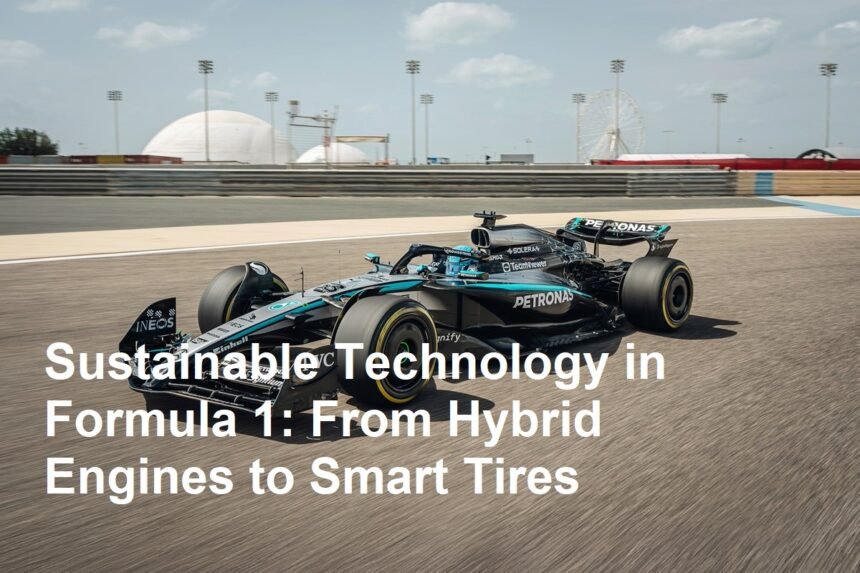Introduction
Formula 1 has long been seen as the pinnacle of speed, engineering, and innovation. But in recent years, it’s also become a testing ground for sustainability. With global attention on climate change, sustainable technology in Formula 1 is no longer optional—it’s a necessity.
From hybrid racing cars to eco-friendly motorsport solutions like smart tires and carbon-neutral goals, F1 is redefining what racing means in the 21st century. In this article, we’ll explore these innovations, discuss why they matter, and share practical tips for fans and industries interested in sustainable tech.
Why Sustainability Matters in Formula 1
The Shift Toward Green Innovation
For decades, F1 was criticized for being fuel-hungry and environmentally unfriendly. Today, the sport has made a bold commitment to become carbon-neutral by 2030. This has led to major investments in cleaner engines, renewable energy, and smarter materials.
Practical Tip: Fans can follow F1’s official sustainability roadmap online to stay updated on how the sport is adapting and how these innovations may impact everyday automotive technology.
Formula 1 as a Testing Ground
What happens in Formula 1 doesn’t stay in Formula 1. Many technologies tested on the track eventually find their way into road cars—making racing an important driver for sustainable mobility.
Hybrid Racing Cars: The Future of Speed
The Evolution of Hybrid Engines
Modern F1 cars are no longer just powered by roaring combustion engines. They use advanced hybrid racing cars systems that combine traditional engines with electric power units. These systems recover energy from braking and exhaust heat, then reuse it to boost speed and efficiency.
Practical Tip: If you’re a car enthusiast, look into hybrid and plug-in hybrid road cars. The tech behind them often originates from F1 innovations.
Performance Meets Sustainability
Unlike traditional hybrids focused mainly on fuel savings, F1’s hybrid engines prioritize both performance and efficiency. They’re proof that sustainability doesn’t mean sacrificing speed.
Smart Tires and Eco-Friendly Motorsport
Smarter Tire Design
Tires play a huge role in sustainability. Smart tires in F1 are designed not only for grip and performance but also to last longer and reduce waste. Sensors monitor tire conditions in real time, helping teams make smarter pit-stop decisions.
Practical Tip: As a regular driver, consider using eco-friendly tires for your car. Many manufacturers now offer durable, fuel-saving tires inspired by motorsport tech.
Bio-Based and Recyclable Materials
Formula 1 is experimenting with more sustainable tire materials, such as bio-based compounds and recycling initiatives. This could significantly reduce waste in the long term.
Beyond Cars: Broader Eco-Friendly Motorsport Efforts
Renewable Fuels
From 2026, F1 cars will run on 100% sustainable fuels. These synthetic fuels are designed to work in regular combustion engines, meaning they could one day power everyday vehicles without modifications.
Practical Tip: Stay updated on biofuels and e-fuels for road use. They may soon become more available as Formula 1 helps push this technology forward.
Greener Logistics and Events
F1’s sustainability efforts go beyond cars. Teams are cutting emissions from logistics, using renewable energy at events, and reducing single-use plastics.
Practical Tip for Fans: Support eco-friendly choices when attending races—like using public transport, bringing reusable bottles, or purchasing sustainable merchandise.
Challenges in Building a Sustainable Formula 1
Balancing Performance and Sustainability
The biggest challenge is maintaining the excitement of high-speed racing while reducing emissions. Fans love the roar of engines, and finding a balance between tradition and innovation isn’t easy.
High Costs of Green Tech
Developing hybrid systems, sustainable fuels, and smart tires requires huge investments. Smaller teams often struggle to keep up with the financial demands of going green.
Fan Expectations
Some fans worry that making F1 too eco-friendly could take away from the drama of the sport. The challenge lies in proving that green tech can still deliver thrilling races.
Practical Tips for Fans and Auto Enthusiasts
Learn from F1 Innovations
Follow how hybrid systems, fuel efficiency, and tire innovations from Formula 1 are making their way into consumer cars. This knowledge can help you make smarter choices when buying your next vehicle.
Support Eco-Friendly Motorsport
Show your support by engaging with F1’s sustainability programs, watching content about their green initiatives, and spreading awareness.
Drive Green in Daily Life
- Opt for hybrid or electric vehicles if possible.
- Use eco-friendly tires to save fuel.
- Reduce unnecessary idling and adopt smoother driving habits.
The Future of Sustainable Technology in Formula 1
Fully Electric? Not Yet
While Formula E is dedicated to electric racing, Formula 1 is focusing on hybrid solutions and synthetic fuels to balance tradition with sustainability.
Smarter AI-Driven Racing
Artificial intelligence may soon play a bigger role, optimizing fuel use, tire wear, and race strategies to make F1 both greener and more competitive.
Expanding Influence Beyond the Track
The long-term vision is clear: F1 wants to influence the automotive industry globally, pushing road cars toward cleaner, more efficient technologies.
Conclusion: Green Speed for a New Era
The future of racing is fast, thrilling, and—most importantly—sustainable. With innovations in sustainable technology Formula 1, from hybrid racing cars to smart tires and eco-friendly fuels, the sport is proving that speed and sustainability can coexist.
F1 isn’t just entertaining fans—it’s shaping the future of eco-friendly motorsport and everyday driving.
Now it’s your turn! Do you think sustainability will make Formula 1 more exciting or take away from its traditional thrill? Share your thoughts in the comments below!












